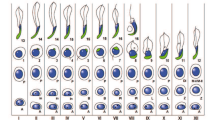Abstract.
A comparatively low yield of germ cells has been reported for the spermatogenic process in primates. Kinetic studies of spermatogenesis and the spermatogenic cycle are needed to investigate this phenomenon but require the application of radioactively labeled compounds or irradiation. We have therefore investigated the suitability of a non-radioactive approach, viz., administration of 5-bromodeoxyuridine, for the determination of the kinetics of the spermatogenic cycle in a non-human primate, the rhesus monkey (Macaca mulatta). Four adult in-season animals received a bolus of 33 mg/kg 5-bromodeoxyuridine, one testis from each monkey was removed 3 h later and the other testis after 10 days and 11 h. Tissue was fixed in Bouin’s solution and embedded in Paraplast. 5-Bromodeoxyuridine was localized by immunogold-silver staining with a monoclonal antibody. PAS-hematoxylin counterstaining was used for spermatogenic stage identification. At 3 h, the leptotene and zygotene spermatocytes in stages VII–IX were the most advanced 5-bromodeoxyuridine-positive cells. At 10 days 11 h, the label had advanced and pachytene spermatocytes in stages VI–IX contained 5-bromodeoxyuridine. The duration of the spermatogenic cycle was 10.42±0.07 days (range: 10.25–10.62 days). Peritubular cells and interstitial cells were rarely 5-bromodeoxyuridine-positive, and Sertoli cells were consistently negative for 5-bromodeoxyuridine. Importantly, our kinetic data closely resemble those obtained by means of the application of irradiation for this macaque species. We conclude that administration of 5-bromodeoxyuridine represents a non-radioactive reliable approach for studying kinetic aspects of the spermatogenic process in primates.
Similar content being viewed by others
Author information
Authors and Affiliations
Additional information
Received: 26 August 1996 / Accepted: 7 November 1996
Rights and permissions
About this article
Cite this article
Rosiepen, G., Arslan, M., Clemen, G. et al. Estimation of the duration of the cycle of the seminiferous epithelium in the non-human primate Macaca mulatta using the 5-bromodeoxyuridine technique. Cell Tissue Res 288, 365–369 (1997). https://doi.org/10.1007/s004410050822
Issue Date:
DOI: https://doi.org/10.1007/s004410050822




